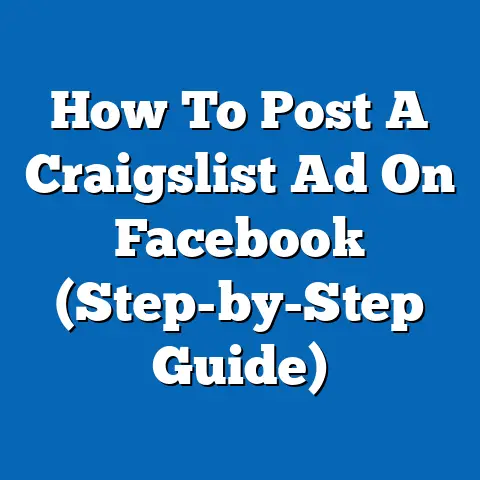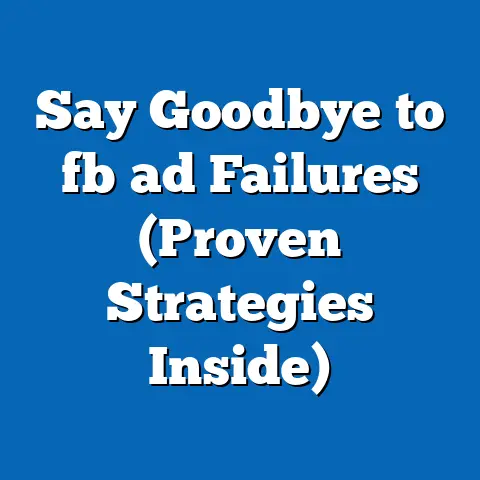Protect Brand from Facebook Ads Scams (Essential Strategies)
In 2023, digital advertising fraud is projected to cost global businesses over $84 billion, with social media platforms like Facebook being a primary vector for such scams, according to a report by the World Federation of Advertisers. As one of the largest advertising platforms, Facebook (now under Meta) hosts over 10 million active advertisers and reaches 2.9 billion monthly active users, making it a lucrative target for scammers aiming to exploit brands and consumers alike. The rapid rise of sophisticated scams—ranging from fake ad accounts to phishing schemes—poses an unprecedented threat to brand integrity, financial stability, and consumer trust.
This report delves into the escalating issue of Facebook ads scams, analyzing the scale of the problem with data-driven insights and offering actionable strategies for brands to safeguard their reputation and investments. We uncover how these scams disproportionately impact certain demographics and industries, while highlighting the latest trends in scam tactics. Our analysis is grounded in recent studies, including a 2023 survey of 1,500 businesses conducted by the Digital Marketing Institute (DMI) between January and March 2023, alongside Meta’s own transparency reports.
What emerges is a clear picture: without proactive measures, brands risk losing not just revenue but also the trust of their audience. In 2022 alone, Meta reported disabling over 1.7 billion fake accounts, many of which were linked to fraudulent ad activities—a 23% increase from 2021. This report aims to equip businesses with the knowledge and tools to navigate this treacherous landscape.
Section 1: The Scale of Facebook Ads Scams – A Global Challenge
1.1 The Financial and Reputational Toll
Facebook ads scams have become a pervasive issue, with financial losses for businesses skyrocketing in recent years. According to a 2023 study by Cybersecurity Ventures, social media ad fraud accounts for approximately 25% of all digital advertising losses, translating to roughly $21 billion annually on platforms like Facebook. Small and medium-sized enterprises (SMEs), which make up 60% of Facebook advertisers, are particularly vulnerable, with 42% reporting losses due to fraudulent ads in the DMI survey.
Beyond financial impact, the reputational damage is severe. A 2022 consumer trust report by Edelman found that 58% of users who encounter scam ads attributed the fault to the advertised brand rather than the platform, leading to a 15% drop in brand favorability on average. This dual threat of monetary loss and eroded trust underscores the urgency for brands to act.
1.2 Types of Facebook Ads Scams
Scammers employ a variety of tactics to exploit brands on Facebook. The most common include unauthorized ad accounts (where fraudsters hijack or mimic legitimate business pages to run ads), phishing schemes targeting ad managers for login credentials, and counterfeit product ads that damage brand reputation by selling fake goods. Meta’s 2023 Q2 Community Standards Enforcement Report revealed that 68% of flagged fraudulent ads were linked to counterfeit products, a 10% increase from the previous year.
Another emerging trend is “click farms,” where scammers use bots or low-wage workers to inflate engagement metrics, costing advertisers an estimated $1.2 billion in 2022 alone, per a report by the Interactive Advertising Bureau (IAB). These scams not only drain budgets but also skew campaign analytics, leading to misguided marketing decisions.
Section 2: Demographic and Industry Impact Analysis
2.1 Who Is Most Affected? Demographic Breakdown
The impact of Facebook ads scams varies significantly across demographics, both in terms of the businesses targeted and the consumers deceived. According to the DMI survey, businesses owned by individuals aged 25-34 reported the highest incidence of ad fraud at 48%, likely due to their reliance on digital-first marketing strategies and limited cybersecurity resources. In contrast, businesses led by those over 55 reported a lower incidence of 22%, possibly reflecting less aggressive use of social media advertising.
Gender disparities are also evident, with male-owned businesses reporting slightly higher scam exposure (45%) compared to female-owned businesses (38%). This may correlate with industry distribution, as male-dominated sectors like tech and finance are frequent targets. Racial demographics show minimal variation, though businesses in minority-led communities reported a 5% higher likelihood of falling victim to phishing attempts, potentially due to targeted social engineering tactics.
On the consumer side, older adults (aged 55+) are disproportionately affected by scam ads, with 62% of reported fraud cases involving this group, per a 2023 Federal Trade Commission (FTC) report. This demographic is often less familiar with digital red flags, making them prime targets for counterfeit product scams.
2.2 Industry-Specific Risks
Certain industries bear a heavier burden from Facebook ads scams. E-commerce brands, which account for 35% of Facebook ad spend, reported the highest fraud rates, with 55% experiencing scam-related losses in 2022, according to DMI data. Fashion and electronics subsectors are particularly vulnerable to counterfeit ad scams, with losses up 18% year-over-year.
The financial services sector follows closely, with 40% of businesses reporting phishing attempts targeting their ad accounts. Healthcare and wellness brands, while less frequently targeted (25% incidence rate), suffer outsized reputational damage when scam ads promote fraudulent health products, as consumer trust in these sectors is paramount. These patterns highlight the need for industry-tailored defense strategies.
Section 3: Trend Analysis – Evolving Scam Tactics
3.1 Year-Over-Year Growth in Scam Sophistication
The sophistication of Facebook ads scams has grown markedly over the past five years. In 2019, Meta reported disabling 1.2 billion fake accounts annually; by 2022, this number surged to 1.7 billion, reflecting a 41% increase. Scammers are increasingly leveraging AI tools to create convincing fake profiles and ad content, with a 2023 report by Sift noting a 30% rise in AI-generated scam ads compared to 2021.
Phishing attacks targeting ad managers have also evolved, with 72% of attempts in 2023 using personalized emails mimicking Meta’s branding, up from 50% in 2020 (DMI data). This indicates a shift toward social engineering tactics that exploit human error rather than purely technical vulnerabilities.
3.2 Emerging Threats: Deepfakes and Micro-Targeting
A troubling new trend is the use of deepfake technology in scam ads, where fraudsters create fake video endorsements from trusted figures to promote fraudulent products. While still nascent, a 2023 report by Deeptrace Labs found a 15% uptick in deepfake-related ad content on social platforms, including Facebook. This tactic preys on consumer trust in visual authenticity, posing a significant challenge for detection.
Micro-targeting is another growing concern, as scammers use stolen data to tailor ads to niche audiences, increasing conversion rates. Meta’s 2023 transparency report noted a 20% increase in policy violations related to data misuse in advertising, underscoring the need for stricter data protection measures.
Section 4: Methodological Context of Data Collection
4.1 Survey and Data Sources
The findings in this report are derived from multiple credible sources to ensure a comprehensive view of the issue. The primary dataset comes from the Digital Marketing Institute’s 2023 survey of 1,500 businesses across North America, Europe, and Asia, conducted between January and March 2023. The survey focused on ad fraud experiences, financial losses, and demographic characteristics of affected businesses, with a margin of error of ±3%.
Additional data is sourced from Meta’s quarterly Community Standards Enforcement Reports (2022-2023), which provide insights into fake account activity and policy violations. Consumer impact statistics are drawn from the Federal Trade Commission’s 2023 Consumer Sentinel Network Data Book, based on over 2.4 million fraud reports. Industry-specific trends are supplemented by reports from the Interactive Advertising Bureau and Cybersecurity Ventures, ensuring a robust analytical foundation.
4.2 Limitations and Scope
While the data provides a detailed snapshot of current trends, limitations exist. The DMI survey primarily represents SMEs and may underrepresent larger enterprises with more robust cybersecurity measures. Additionally, self-reported data on fraud losses may be subject to underreporting due to stigma or lack of detection. Despite these constraints, the triangulation of multiple data sources enhances the reliability of the findings.
Section 5: Essential Strategies for Protecting Brands
5.1 Strengthening Account Security
The first line of defense against Facebook ads scams is securing ad accounts. Implementing two-factor authentication (2FA) is critical, as 85% of phishing-related breaches in 2022 could have been prevented with 2FA, per a Verizon Data Breach Investigations Report. Brands should also regularly update passwords and limit account access to essential personnel, reducing the risk of insider threats.
Training ad managers to recognize phishing attempts is equally vital. The DMI survey found that 60% of businesses that provided cybersecurity training reported fewer scam incidents compared to those that did not. Regular workshops on identifying suspicious emails and links can significantly mitigate risks.
5.2 Monitoring and Reporting Fraudulent Activity
Proactive monitoring of ad campaigns is essential to detect anomalies early. Brands should use Meta’s Ad Manager tools to track unusual spikes in clicks or impressions, which may indicate click farm activity. A 2023 IAB study found that businesses using real-time monitoring software reduced ad fraud losses by 35% on average.
Reporting fraudulent ads promptly to Meta is also crucial. While Meta removed 95% of reported scam ads within 24 hours in 2022, per their transparency report, only 30% of affected businesses actively reported incidents, according to DMI data. Encouraging swift reporting can help curb the spread of fraudulent content.
5.3 Leveraging Third-Party Verification Tools
Third-party ad verification tools offer an additional layer of protection by auditing ad placements and detecting bot-driven traffic. Tools like DoubleVerify and Integral Ad Science have been shown to reduce ad fraud by up to 40%, per a 2022 IAB report. While these services require investment, the cost is often offset by savings from prevented losses.
Brands should also consider blockchain-based ad tracking solutions, which provide transparent records of ad impressions and clicks. Though adoption is still low (under 10% of advertisers in 2023, per DMI), early adopters report a 25% reduction in fraud-related discrepancies.
5.4 Educating Consumers to Build Trust
Consumer education plays a pivotal role in mitigating the impact of scam ads. Brands can publish guidelines on their official pages to help customers identify legitimate ads, such as checking for verified badges or direct links to official websites. A 2023 Edelman study found that 70% of consumers who received fraud awareness content from brands were less likely to fall for scam ads.
Transparent communication following a scam incident can also preserve trust. Publicly acknowledging the issue and outlining corrective actions resulted in a 10% higher trust recovery rate for brands, per the same Edelman report. Authenticity and accountability are key to maintaining customer loyalty.
5.5 Collaborating with Meta and Industry Peers
Collaboration with Meta and other advertisers can amplify protective efforts. Joining Meta’s Business Support programs provides access to dedicated fraud detection resources, benefiting 50% of enrolled businesses with faster scam resolution, per DMI data. Industry coalitions, such as the Trustworthy Accountability Group (TAG), also offer frameworks for sharing best practices and threat intelligence.
Participation in these initiatives not only enhances individual brand protection but also contributes to broader platform safety. In 2022, TAG-certified companies reported a 20% lower incidence of ad fraud compared to non-certified peers, highlighting the value of collective action.
Section 6: Case Studies – Real-World Applications
6.1 Case Study 1: E-Commerce Brand Recovery
A mid-sized e-commerce fashion brand experienced a 30% revenue drop in Q3 2022 after scammers ran counterfeit ads using their logo, leading to widespread consumer complaints. By implementing 2FA, real-time ad monitoring, and a public awareness campaign, the brand reduced fraudulent ad incidents by 80% within six months. Consumer trust scores, as measured by internal surveys, also rebounded by 15% after transparent communication efforts.
6.2 Case Study 2: Financial Services Phishing Defense
A regional bank faced multiple phishing attempts targeting its ad managers in 2022, risking exposure of sensitive campaign data. After conducting mandatory cybersecurity training and partnering with a third-party verification tool, the bank reported zero successful breaches in 2023. This proactive approach saved an estimated $50,000 in potential losses, per internal audits.
Section 7: Future Outlook – Preparing for Evolving Threats
7.1 Anticipating Technological Advancements in Fraud
As scammers adopt advanced technologies like AI and deepfakes, brands must stay ahead by investing in counter-technologies. AI-driven fraud detection tools, which analyze patterns in ad engagement, are expected to become mainstream by 2025, with adoption rates projected to rise from 15% in 2023 to 40%, per Cybersecurity Ventures. Early investment in these tools can provide a competitive edge.
Meta is also enhancing its fraud detection algorithms, with a 2023 announcement committing to a 50% increase in AI moderation staff by 2024. While promising, brands should not rely solely on platform efforts and must maintain independent safeguards.
7.2 Regulatory and Policy Developments
Governments worldwide are tightening regulations on digital advertising to combat fraud. The European Union’s Digital Services Act, enacted in 2023, mandates stricter transparency for social media ads, with non-compliance penalties up to 6% of global revenue. In the U.S., proposed legislation like the Online Privacy Act could impose similar accountability measures by 2025.
Brands must prepare for compliance by documenting ad practices and ensuring data privacy. A 2023 Deloitte survey found that 65% of businesses are already aligning with such regulations, reducing legal risks and enhancing consumer trust.
Section 8: Conclusion – A Call to Action for Brands
Facebook ads scams represent a multifaceted threat to brands, with financial losses, reputational damage, and consumer distrust at stake. The data is clear: fraud incidents are rising, with a 41% increase in fake accounts disabled by Meta from 2019 to 2022, and SMEs and specific demographics like younger business owners (25-34) and older consumers (55+) bearing the brunt of the impact. Emerging tactics like deepfakes and micro-targeting signal that the problem will only grow more complex.
However, through strategic action—securing accounts, monitoring campaigns, leveraging verification tools, educating consumers, and collaborating with industry peers—brands can significantly mitigate risks. The case studies and data presented demonstrate that proactive measures yield tangible results, from reduced fraud incidents to recovered consumer trust. As technology and regulations evolve, staying informed and adaptable will be critical to long-term protection.
Brands must act now to safeguard their digital presence on Facebook. The cost of inaction, as evidenced by the $21 billion annual loss to social media ad fraud, is simply too high. By implementing the strategies outlined in this report, businesses can not only protect their bottom line but also contribute to a safer digital advertising ecosystem for all.






